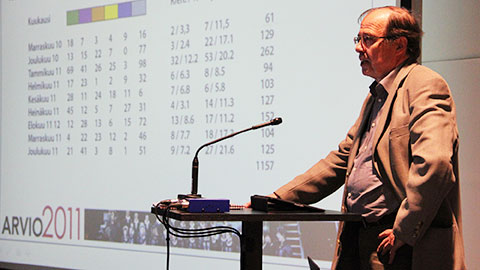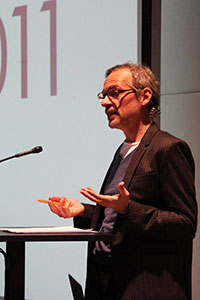Science Was Turku´s Legacy for Future Capitals of Culture
Turku’s Capital of Culture year 2011 was an excellent example for future capitals of culture, with its emphasis on well-being and programme that encouraged the active participation of people. A significant new initiative was also the introduction of scientific research into the year’s programme.

- It is worthwhile holding on to these things and developing them further, said Professor Harri Andersson of the University of Turku on Friday in Logomo, Turku, at the publication of the evaluation study on Turku’s Capital of Culture year.
The working group headed by the University of Turku evaluated the impact of Turku’s Capital of Culture year up to 2016. The section of the two-part evaluation programme headed by Professor Harri Andersson mainly evaluates the period 2010−2012 and focuses on three themes: the Capital of Culture as a process, to whom did the Capital of Culture belong, and what did it leave behind. Work on the period covering 2013−2016 is being led by Adjunct Professor Päivi Rannila from the University of Turku.
Together with the evaluation report, Turku 2011 – The Capital of Science and Culture, a compilation of 15 articles on science and the arts in Turku’s Capital of Culture year, was also published.
Sylvain Pasqua, who works at the European Commission’s Directorate General for Education and Culture, attending the publication of the evaluation report and compilation of articles, thanked Turku for evaluating what the Capital of Culture year had to offer and for looking far into the future. On behalf of the Commission, Pasqua participates in the selection of capitals of culture and in the preparation of new legislation concerning them.
 - The European Capitals of Culture can produce huge cultural, economic and social benefits for cities holding the title. For that to happen, they must be embedded in the long term development strategy of the cities, and cities must have evaluation tools at their disposal to better steer the whole process. That is why the on-going evaluation being carried out in Turku is so important and exemplar. It provides the city of Turku with the opportunity to better understand the many changes which have been - and are still being - induced through hosting the title, and better accompany future developments, said Pasqua.
- The European Capitals of Culture can produce huge cultural, economic and social benefits for cities holding the title. For that to happen, they must be embedded in the long term development strategy of the cities, and cities must have evaluation tools at their disposal to better steer the whole process. That is why the on-going evaluation being carried out in Turku is so important and exemplar. It provides the city of Turku with the opportunity to better understand the many changes which have been - and are still being - induced through hosting the title, and better accompany future developments, said Pasqua.
- I can only invite your city to continue making the most of its year as European Capital of Culture, said Pasqua.
According to Minna Arve, Chairperson of the Board of the Turku 2011 Foundation, the City of Turku wishes to strongly maintain and develop the key resource from its Capital of Culture year, namely co-operation between the city, universities and those working in the culture sector.
- The networking of creativity born as a result of the process is a tremendous resource, which will carry far into the future. Culture is a key area of focus in the city’s strategy work and urban research programme, said Arve, who gave the opening address at the event.
A Programme for Various Population Groups
The evaluation report shows that building the programme entity was among the most important parts of the Capital of Culture process. Diverse, it offered different population groups the chance to participate in the year’s activities in many ways.
- The programme showed that culture and creativity are important elements in various areas of life. In this task, the Capital of Culture programme was very successful, says Andersson.
The complex structure of the programme did, however, also hamper the visibility of events. According to the report, the Capital of Culture programme was difficult to manage, despite good communications. This is why many interesting events in the everyday environment remained undetected. Major individual events were most easily found. This was also reflected in the news coverage on the events.
The Concept of Culture Diversified
One prominent outcome of Turku’s Capital of Culture year is the spirit of participation and well-being highlighted by the foundation and through publicity. The Whose Capital of Culture section of the evaluation report looked at how people participated in the year’s activities and how the different ways of participation affected the involvement of people. Did people attend cultural events as mere spectators, did they take part in the events or did they actually create them themselves?
Based on the report, the programme offered the chance for all of these. For example, Fire! Fire!, the Capital of Culture’s main Logomo exhibition, was valued particularly because of its interactive nature and family perspective.
- From a point of view of participation, one of the most enduring effects of the Capital of Culture year are the ways in which people consume culture. The significance of the different forms of culture has diversified and affected people’s ways of life. This has been experienced by the people of Turku in particular, says Andersson.
Urban space was evaluated by juxtaposing two different Capital of Culture main stages: the public and open surroundings of the River Aura and the private and more closed Logomo.
Logomo was clearly profiled in people’s minds as a centre of culture, which is not, however, the main objective of the renovation plans designed for it. The position of the River Aura as Finland’s most significant urban river was, however, strengthened as a setting for cultural events on account of the Capital of Culture year.
A New Foundation Created by More Spontaneity
In a separate section of the evaluation programme, the Finland Futures Research Centre of the University of Turku evaluated the unexpected effects of the Capital of Culture year. A significant observation was that the year promoted spontaneity and lowered the threshold for participation in the production of art and culture.
As a result of the year, culture was also discussed more than usual, and it was much easier than before to attend events, even those in unusual places.
- Participation was nonetheless mainly in the form of spectatorship. A real change would take place if spectators transformed from consumers to producers. Spontaneity, people doing things themselves, participation and crowdsourcing could create a black swan, an unexpected effect, which might change the atmosphere, way of doing things and everyday culture of the whole city. People should be even bolder to encounter new forms of art and culture, said Andersson.
The Unprecedentedly Strong Involvement of Science
Harri Andersson encourages future capitals of culture to combine science and culture, just as Turku did. Turku created an unprecedentedly extensive and diverse programme of research as part of the Capital of Culture year.
 The official Turku 2011 programme included 12 research projects run by universities and 14 joint productions of science and the arts. The ideas inspired by them can be read in the compilation of articles, which discusses the heritage of Turku’s Capital of Culture year, its economic, social and cultural impact as well as the creative infrastructure involved.
The official Turku 2011 programme included 12 research projects run by universities and 14 joint productions of science and the arts. The ideas inspired by them can be read in the compilation of articles, which discusses the heritage of Turku’s Capital of Culture year, its economic, social and cultural impact as well as the creative infrastructure involved.
The writers of the collection of articles opine that the best things Turku 2011 produced were the new networks uniting culture with other fields, the planning stage open to all Turku residents that preceded the actual Capital of Culture year, and cultural activity produced in a novel manner in public urban spaces, which reached into the everyday life of the people of Turku. Turku 2011 created new communality and a ‘capital of culture spirit’, contributing to the success of the entire year.
In spite of Turku’s recommendable models, Professor Andersson encourages future capitals of culture to be bold in their programmes and not tread the paths taken by previous incumbents.
- Capitals of culture are also instruments of imitation, which is not a negative thing in itself, if programme content considered good is used or if the capitals’ events are developed based on this content. In any case, capitals of culture should also have their own new initiatives and experimental forms of art, which would enrich the European cultural environment, says Andersson.
Photographs: Sylvain Pasqua from the European Commission’s Directorate General for Education and Culture (above) and Editor of the article collection Jukka Vahlo.
HB
Photographs: Tuomas Koivula